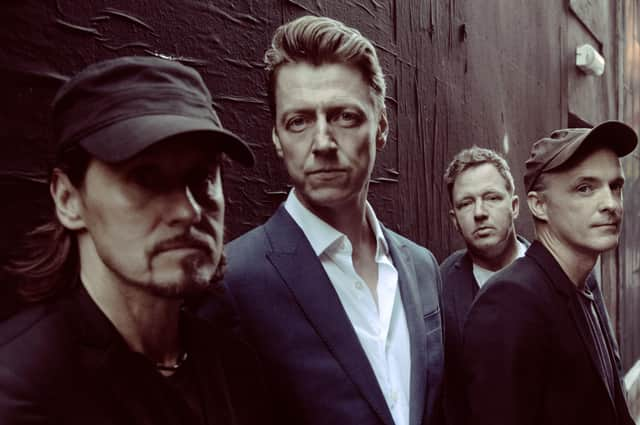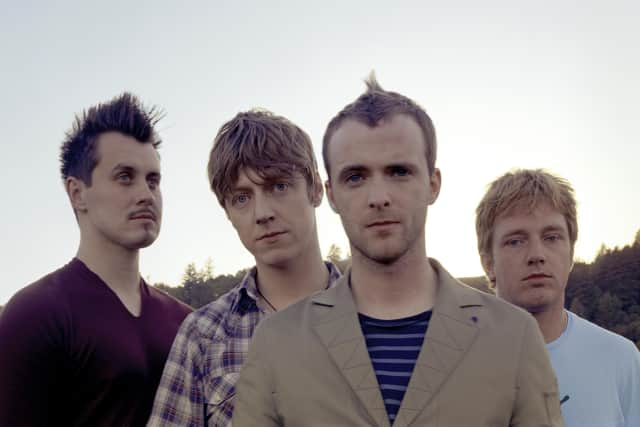Travis: ‘It was never about us as individuals or us as pop stars, it was purely about the songs’


Hot off a 19-month world tour, Fran Healy, Dougie Payne, Andy Dunlop and Neil Primrose arrived at Ocean Way studios on Sunset Boulevard in Los Angeles high in confidence and with a stack of musical ideas in their locker.
They were working with the same producer, Nigel Godrich, while also in town at the same time were friends such as the comedian Adam Buxton, Jason Falkner of Jellyfish and Neil Hannon of The Divine Comedy.
Advertisement
Hide AdAdvertisement
Hide AdWhat the band hadn’t bargained for, Payne recalls 20 years on, was Godrich rejecting almost everything they proferred up.
“It sounds such a lovely, smooth record, kind of effortless, but actually it was quite a tricky one to make,” says the bassist, now 49. “I think Nigel had had a tough time making Kid A with Radiohead so he was in a kind of interesting place, quite different from when we worked with him on The Man Who. He was quite tough on us.
“We’d spent a lot of time in the preceding year working on new stuff and working up arrangements to ensure we were ready to go into the studio and start recording but everything we played Nigel would go ‘No, don’t like it’ or ‘I like the song but I don’t like the arrangement’.
“It ended up after the first week with me and Franny sitting out in the car park of Ocean Way going, ‘Oh my God, how are we going to make this record?’ We were head in hands going, ‘He hates us, he thinks the songs are rubbish, he’s going to walk. What are we going to do?’”
Advertisement
Hide AdAdvertisement
Hide AdFortunately in the second week, things began to gel. Payne remembers: “We scrapped all the arrangements that we had and we actually went to a shop called Black Market Music and bought a whole load of weird instruments, little beat boxes and drone generators, strange little keyboards and started playing around with them, then we started working from the foundations up with the songs.


“If you listen to the reissue of the album there’s this sound like a tanpura, almost like an Indian drone, that keeps popping up throughout the record, that thing we set it up in the middle of the room and put a mic on it and it just comes in and out, it was almost like the atmosphere it created there. And then Nigel just got into his Nigel frame of mind because we had cheered him up a bit.
“Again it became similar to what happened with The Man Who, which is our pop sensibilities – we’re three-minute pop song writers, all about melody – and his left-field leanings, it just throws us into a more interesting place.”
Gradually through experimentation the likes of The Humpty Dumpty Love Song, Side and Sing began to “really coalesce”. Payne recalls: “The backwards tubular bells at the start of Sing, that was the moment when we were like, ‘Oh, we’re onto something’. Nigel had been getting Andy to play certain notes on the tubular bells and he’d been recording them on back-to-back tape, and he turned the tape round and we went in and that was the intro then the song started and (we thought) ‘This is interesting, this is sounding quite magnetic’. Then it all flowed from there and we ended up having a good time in the studio as well, leaning into Nigel’s experiments like building a drum kit out of cardboard boxes for Flowers in the Window and that kind of thing. As well as being a fun time socially outside of the studio, it ended up being a fun time in the studio too.”
Advertisement
Hide AdAdvertisement
Hide AdThe album’s title refers to how Healy, Payne, Dunlop and Primrose felt they were perceived at the time. Twenty years later, the bassist says they were actually quite happy that their songs were better known than their creators.
“We liked it,” he says. “Even coming back to the first album, Good Feeling, the whole mantra was ‘it’s the songs first’. It goes from how you play, what parts you write for the songs, you’re always performing for the songs. It was never about us as individuals or us as pop stars, it was purely about the songs. (Naming the album The Invisible Band) was really to underline that, rather than to mention it in any kind of resentful way. It was to say it’s almost how it should be.
“With The Man Who we were all over the place but we could walk down the street completely unmolested, we were completely unrecognisable, and that was how we liked it. The irony was with The Invisible Band it then made really Fran quite a visible presence and I think he then found that quite difficult to deal with.”
The Invisible Band would go on to be one of the best-selling albums of the decade – in an era when CD was king – with individual tracks featured heavily in films and television. Payne says it was pleasing that the songs went on to have a life of their own. “Songs are made to get into people’s lives, into their living rooms, into their minds and for want of a better word, their hearts,” he says. “I’m sure everybody’s the same, but I’ve certainly been helped by music through bad times and had music exacerbate good times, and that’s what songs are there for. So whatever it takes, whether it’s films or TV shows or adverts, they’re like postmen: if they deliver the songs to people then that’s a good thing.”
Advertisement
Hide AdAdvertisement
Hide AdTravis’s success was later cited as paving the way for bands such as Coldplay and Keane with their more sensitive form of songwriting after the brashness of the Britpop era. Payne says: “These narratives are always written by the press and they’re adopted by people who read the press like myself, I’m a keen reader of the music press and always have been. But the thing is it’s much more general and less deliberate than that. These narratives are always constructed after the fact.
“When we started you had Oasis and Blur and Pulp and Suede kicking down doors and getting success and then we followed them down the corridor. We were inspired by these people but then we ended up doing something that was maybe a bit more introspective. I always characterise it as the hangover from the Britpop party – that was The Man Who – but at that time, after the whole Parklife and (What’s The Story) Morning Glory, in ’97 when we started, it was Urban Hymns by The Verve and OK Computer (by Radiohead) and things were naturally becoming maybe darker, there was less hubris in the air. The Man Who was definitely a reflection of that.
“Then after that the record industry is quite unimaginative, they’ll see things that are successful. At the time we were signed because we were a rock band and we were coming down the corridor after Oasis and that stuff. Then we went out and signed a slew of bands after we got successful and some of them got very successful in their own right and that’s just how it works, I don’t think anybody really goes out to ape or copy, it’s just (a situation where) that’s in the airwaves and you start thinking ‘oh you can do that’. And so it goes on.”
The Invisible Band 20th anniversary remaster is out now. Travis play at O2 Academy Leeds on May 11, 2022. travisonline.com
Comment Guidelines
National World encourages reader discussion on our stories. User feedback, insights and back-and-forth exchanges add a rich layer of context to reporting. Please review our Community Guidelines before commenting.